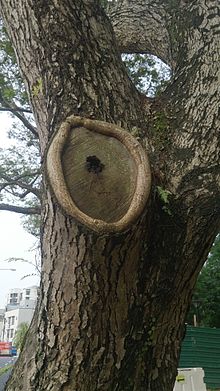Bark pocket

Bark pockets are patches or inclusions of bark partially or fully embedded in the wood of a tree. They can also be used as biomonitors. Bark pockets are considered a nuisance in the lumber industry because they are considered a defect, and lower the grade of the wood.[1] Bark pockets can also weaken tree forks, and can result in damage to the junction under stress.[2]
Formation


Bark pockets can be formed by inosculation, formation of a tree fork, encapsulation of a branch, joining together of an uneven trunk, or encapsulation of another object.[3][4] During inosculation, the bark trapped between the two joining trunk becomes surrounded with wood once the trunks fuse. The resulting bark pocket formed during inosculation or in a tree fork is referred to as included bark.
When a branch is encapsulated, the outer bark on the branch may remain inside the wood of the tree, as the trunk widens and grows around the branch.
As biomonitors
Bark pockets can be used as an indicator of air pollutants during which the time they formed.[5] They can be used to monitor heavy metals such as lead and copper, as dust or other matter deposited on the bark at the time of formation is still present.[6][7] One study analysed the amount of polycyclic aromatic hydrocarbons (PAH) using a bark pocket, possible due to the interaction between PAHs and lipids in the bark.[8]
References
- ^ http://www.statesind.com/page/veneer-grading Veneer Grading
- ^ http://www.forestry.gov.uk/pdf/fcpg13.pdf/$file/fcpg13.pdf Hazards From Trees
- ^ http://oilpeak.web.fc2.com/myenvironmentalism/science/treebark/satake.htm Tree "bark pocket" as pollution time capsule for historical monitoring.
- ^ http://vancouverdoorco.com/knots-burls-and-bark-pockets Knots, Burls, and Bark Pockets
- ^ http://oilpeak.web.fc2.com/myenvironmentalism/science/treebark/satake.htm Tree "bark pocket" as pollution time capsule for historical monitoring.
- ^ https://www.researchgate.net/publication/248404567_Monitoring_of_heavy_metals_in_airborne_particles_by_using_bark_samples_of_japanese_cedar_collected_from_the_metropolitan_region_of_Japan Monitoring of heavy metals in airborne particles by using bark samples of japanese cedar collected from the metropolitan region of Japan.
- ^ https://www.researchgate.net/publication/229195228_Utilization_of_bark_pockets_as_time_capsules_of_atmospheric-lead_pollution_in_Norway Utilization of bark pockets as time capsules of atmospheric-lead pollution in Norway.
- ^ http://pubs.acs.org/doi/abs/10.1021/es049685j Historical Records of Airborne Polycyclic Aromatic Hydrocarbons by Analyzing Dated Corks of the Bark Pocket in a Longpetiole Beech Tree
